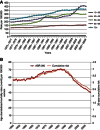The benefits and harms of breast cancer screening: an independent review
- PMID: 23744281
- PMCID: PMC3693450
- DOI: 10.1038/bjc.2013.177
The benefits and harms of breast cancer screening: an independent review
Figures







Comment in
-
Mortality benefits and overdiagnosis estimates for women attending breast screening.Br J Cancer. 2013 Jun 11;108(11):2413-4. doi: 10.1038/bjc.2013.260. Epub 2013 Jun 6. Br J Cancer. 2013. PMID: 23744279 Free PMC article. No abstract available.
-
Breast cancer screening: time to target women at risk.Br J Cancer. 2013 Jun 11;108(11):2202-4. doi: 10.1038/bjc.2013.257. Epub 2013 Jun 6. Br J Cancer. 2013. PMID: 23744280 Free PMC article. No abstract available.
References
-
- Berry DA, Cronin KA, Plevritis SK, Fryback DG, Clarke l, Zelen M, Mandelblatt JS, Yakovlev AY, Habbema JD, Feuer EJ. Effect of screening and adjuvant therapy on mortality from breast cancer. N Engl J Med. 2005;353 (17:1784–1792. - PubMed
-
- Cancer Research UK 2012Breast Cancer Incidence Statistics.< http://info.cancerresearchuk.org/cancerstats/types/breast/incidence/#sex >(accessed 15 September 2012.
-
- Forrest P. Breast Cancer Screening - Report to the Health Ministers of England, Wales, Scotland and Northern Ireland. Department of Health and Social Security; 1986.
-
- Gotzsche PC, Nielsen M. Screening for breast cancer with mammography. Cochrane Database Syst Rev. 2011. p. CD001877. - PubMed
Publication types
MeSH terms
Grants and funding
LinkOut - more resources
Full Text Sources
Other Literature Sources
Medical

